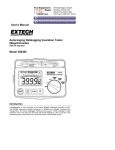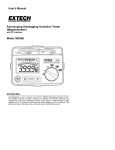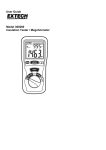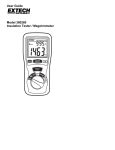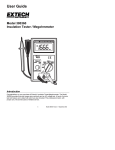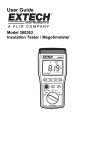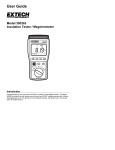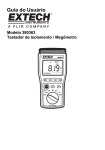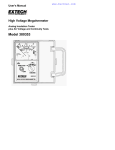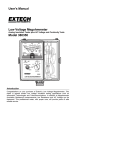Download User's Manual Autoranging Insulation Tester Model - Cole
Transcript
User's Manual Autoranging Insulation Tester with PC Interface Model 380365 WARRANTY EXTECH INSTRUMENTS CORPORATION warrants the basic instrument to be free of defects in parts and workmanship for one year from date of shipment (a six month limited warranty applies on sensors and cables). If it should become necessary to return the instrument for service during or beyond the warranty period, contact the Customer Service Department at (781) 890-7440 for authorization. A Return Authorization (RA ) number must be issued before any product is returned to Extech. The sender is responsible for shipping charges, freight, insurance and proper packaging to prevent damage in transit. This warranty does not apply to defects resulting from action of the user such as misuse, improper wiring, operation outside of specification, improper maintenance or repair, or unauthorized modification. Extech specifically disclaims any implied warranties or merchantability or fitness for a specific purpose and will not be liable for any direct, indirect, incidental or consequential damages. Extech's total liability is limited to repair or replacement of the product. The warranty set forth above is inclusive and no other warranty, whether written or oral, is expressed or implied. Introduction Congratulations on your purchase of Extech’s Insulation Tester. Special features include Autoranging measurement display, RS-232 PC Interface for data acquisition, and backlit LCD display with analog indicator. This professional meter, with proper care, will provide years of safe reliable service. Safety 1. Circuits under test must be de-energized and isolated before connections are made (except for voltage measurements). 2. Circuit connections must not be touched during a test. Use extreme caution when working near bare conductors and bus bars. Accidental contact with conductors could result in electrical shock. 3. Use caution when working near voltages above 60VDC or 30VACrms. 4. After insulation tests, capacitors must be discharged. 5. Test leads (including alligator clips) must be in good working order, clean and without broken or cracked insulation. 6. When servicing, use only specified replacement parts. International Safety Symbols Caution, refer to this manual before using this meter Dangerous Voltages Meter is protected throughout by double or reinforced insulation 2 Specifications General specifications Display Backlit 3-3/4 digit (4000 count) LCD with analog indicator Sampling rate 2.5 samples/sec. (digital); 10 samples/sec. (analog) Audible Continuity 200Ω range with audible tone when resistance < 40Ω Over range indicator "OL” displayed when measurement exceeds range limits Low battery indicator " - +" symbol displayed when battery voltage is low Power source Eight 1.5V AA cells Pow er consumption 20 to 90mA depending upon function Operating conditions 32 to 104oF (0 to 40oC); < 80% RH Storage conditions 14 to 140oF (-10 to 60oC); < 80% RH Dimensions 7.5 x 5.5 x 3” (190 x 140 x 77mm) Weight 2 lbs (900g) Range Specifications Resis tance Range Res. Accuracy ±1% + 5d 400Ω 0.1 Ω Short circuit current: 280mA (min. 200mA) Max. open circuit Volt 12.8V Overload Protect. 220Vrms Continuity Range 200Ω Res. 0.1Ω Audible tone < 40Ω Max. open circuit Volt 12.8V (200mA) Overload Protect. 220Vrms AC Voltage (40 to 500Hz) Range 600VAC Res. 1V Accuracy ±1.5% + 3d Input impedance 4.5MΩ Overload Protect. 220Vrms Megohmmeter (Auto Range) Range 4M /40M /400M / 4000MΩ / 250V 4M /40M /400M / 4000MΩ / 500V 4M /40M /400M / 4000MΩ / 1000V 4000MΩ / 250V 4000MΩ / 500V 4000MΩ / 1000V Res. 1kΩ Accuracy ±3% + 5d (<2000MΩ) ±5% + 5d (>2000MΩ) Test Current / Load 1mA 250KΩ 500KΩ 1MΩ Terminal voltage 250V + 20% ~ -0% 500V + 20% ~ -0% 1000V + 10% ~ -0% Short circuit I < 1.5mA Note: Accuracies are specified as % reading + digits at 23oC < 80% RH 3 Meter Description 1. LCD Display 2. Megohm TEST pushbutton 3. Test LOCK button 4. Data HOLD button 5. LCD Backlight / Auto OFF Wake button 6. Function select switch 7. Storage compartment 8. RS-232 interface jack 9. Measurement input terminals 10. Test Leads Operation Note: Ensure that the circuit under test does not include devices or components that can be damaged by 1000VDC; such devices include power factor correction capacitors, low voltage mineral insulated cables, electronic light dimmers, ballasts and starters for fluorescent lamps. Connecting Test Leads For all functions (Megohm, Resistance, Continuity and AC Voltage), connect the red test lead to the HI terminal and the black lead to the COM terminal. Test Lead Check 1. Set the rotary switch to the resistance / continuity position. 2. Short the test leads and read the LCD value. The resistance is typically less than 1Ω. 3. With the leads open (not shorted), the display should read infinity (over range “-OL-“). 4. If any readings are displayed other than the readings just described, the test leads should be considered faulty and must be replaced before using the meter. Failure to do so could result in damage to equipment and electrical shock. Insulation Resistance Measurements 400M Ω for 250V or 500V Tests 1. After connecting the test leads, turn the rotary switch to the desired range 2. Press and hold down the TEST button 3. The resistance reading will display until the HOLD key is pressed Note on large installations : In large wiring installations where the insulation of outlets is being tested, more than one measurement may have to be made to take into account parallel resistances. Divide large systems into subgroups and test subgroups individually. Also, in large installations, the capacitance of the insulation will be high, thereby taking longer to charge when being tested. Care must be taken not to finish a measurement until the insulation capacitance is fully charged (a steady, stable reading is an indication that this is the case). The charge stored in the insulation after a test will be discharged automatically when the test button is released. Be careful not to turn the range switch while the test button is pressed. 4000M Ω for 1000V Tests 1. Set the range switch to 1000V and proceed as described above for 250/500V testing. 2. Read the “Note on large installations” above. 4 Analog Display Pointer The analog pointer can indicate up to 10GΩ. When the measured value is between 4 and 10GΩ, the LCD displays "-HI-". When the measured value is higher than 10GΩ the LCD displays "-OL-". Note that the charge stored on the device under test will be discharged automatically when the testing process is finished. 3-Minute Test Lock For hands-free operation, use the Test Lock feature. 1. Connect the test leads as previously described 2. Press the LOCK button and then press the red TEST button. A 3-minute continuous test will ensue 3. Press the red TEST button again to end the test if desired 4. If the TEST button is not pressed within 3 minutes, the meter automatically stops the test Low Resistance and Continuity Tests WARNING: Do not run this test unless ACV = 0. Do not use this mode to check diodes. 1. Set the Rotary switch to the audible continuity/resistance position. 2. Connect the red test lead to the HI input terminal; black lead to the COM terminal. 3. Connect the tips of the test leads to both ends of the circuit under test and read the resistance on the LCD. 4. For continuity tests, when the resistance of a circuit is less than approx. 40Ω, an audible tone will sound. AC Voltage Tests 1. Set the Rotary switch to the red ACV position. 2. Connect the red test lead to the HI terminal and the black test lead to the COM terminal. 3. Connect the other end of the test leads IN PARALLEL to the circuit under test. 4. Read the voltage value on the LCD. 5 Applications Measuring Power Tools and Small Appliances This section applies to any device under test that uses a line cord. For double insulated power tools, the megohmmeter leads should be connected to the device’s housing (chuck, blade, etc.) and the ground of the power cord. Refer to the diagram at right. Power cord Appliance Testing Motors AC Motors Disconnect the motor from the line by: 1. Disconnecting the wires from the motor terminals or Meter 2. Opening the main switch. 3. If the main switch is opened, and the motor also has a motor-starter, then the starter must be held in the ON position. With the main switch opened, the measured resistance will include the resistance of the motor wire and all other components between the motor and the main switch. If a weakness is indicated, the motor and other components should be checked individually. If the motor is disconnected at the motor terminals, connect one megohmmeter lead to the grounded motor housing and the other lead to one of the motor leads. Refer to diagram at right. DC Motors 1. Disconnect the motor from the line. 2. To test the brush rigging, field coils and armature, connect one megohmmeter lead to the grounded motor housing and the other lead to the brush on the commutator. 3. If the resistance measurement indicates a weakness, raise the brushes off of the commutator and separately test the armature, field coils and brush rigging by connecting one megohmmeter lead to each individually, leaving the other connected to the grounded motor housing. This also applies to DC Generators. Cables 1. Disconnect the cable being tested from the line 2. Disconnect the cable’s opposite end to avoid errors as a result of leakage from other equipment. 3. Check each conductor to ground and/or lead sheath by connecting one megohmmeter lead to ground and/or lead sheath and the other megohmmeter lead to each of the conductors in turn. 4. Check insulation resistance between conductors by connecting megohmmeter leads to conductors in pairs. Refer to diagram at right. 5. In the diagram, note that the 3-conductor cable has two wires shorted to the ground shield. This two-wire/shield connection is then connected to one side of the meter. The remaining conductor is connected to the other side of the meter. 6 Data Hold Data Hold works automatically on Megohmmeter tests. For other functions, press the HOLD key to freeze the meter reading. Press HOLD again to return to normal operation. Auto Power OFF After a 30-minute period of non-use, the meter automatically shuts down. To wake the meter, press the Backlight / Auto Power OFF Wake button. PC Interface Minimum hardware requirements 486 PC or better, 3.5" disk drive, EGA monitor and 4MB RAM Communications Settings Baud Rate: 9600, Parity: None, Data bits: 8, Stop bits: 1 Connecting the meter to a PC One end of the supplied cable connects to the PC Com Port (DB9) and the other (infrared) connects to the top of the meter. Installing Software (WindowsTM 95/98) 1. Insert the supplied program disk in the PC floppy drive 2. Press the Windows START key and select RUN 3. Type SETUP at the prompt and press ENTER Running the Data Acquisition Software 1. Double click on the Program icon 2. Select PC communications port COM1 or COM2 when prompted 3. The Program screen will appear as a facsimile of the meter's front panel. Creating a File to store data 1. Select FILE from the menu on the software screen 2. Select SAVE AS and type a filename 3. This File can later be opened using the OPEN FILE command 4. Files can be imported in spreadsheet programs as *.dat text files Start Recording 1. Select START RECORDING from the menu heading 2. Data will now be logged every n seconds (where n=desired sampling rate) Setting the Sampling Rate 1. Select SAMPLING from the menu heading 2. Type in the desired rate at which data will be recorded (from 1 to 65 seconds) Open an existing Data File 1. From the FILE menu select OPEN FILE and choose a file from the list 2. A data list appears with Date/Time, Value, Units, & Battery information 3. Select PRINT from the menu heading to print the data list Soft-key Operation The four front-panel key shown on the software screen operate in the same fashion as the actual keys on the meter. 7 Maintenance Battery Replacement When the low battery symbol ( - + ) appears on the lower left side of the LCD the eight 1.5V AA batteries must be replaced. 1. Ensure that the meter is powered down and that the test leads are not connected 2. Remove the two large phillips head screws on the rear of the meter 3. Remove the battery compartment cover 4. Replace the eight AA batteries ensuring proper polarity 5. Affix the rear cover and secure the rear screws Cleaning Periodically wipe the case with a dry cloth. Do not use solvents or abrasives to clean this instrument. Repair and Calibration Extech offers complete repair and calibration services for all of the products we sell. For periodic calibration, NIST certification or repair of any Extech product, call customer service for details on services available. Extech recommends that calibration be performed on an annual basis to insure calibration integrity. Copyright © 2001 Extech Instruments Corporation. All rights reserved including the right of reproduction in whole or in part in any form. Model 380365 V1.1 April 2001 ( parte en cualquier forma." Tech Support Hotlines 781-890-7440 ext. 200 [email protected] 8








